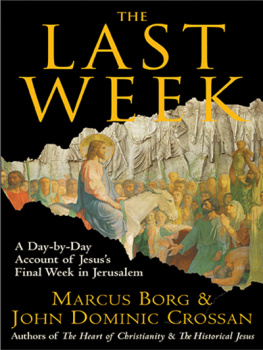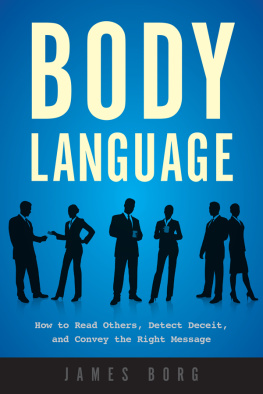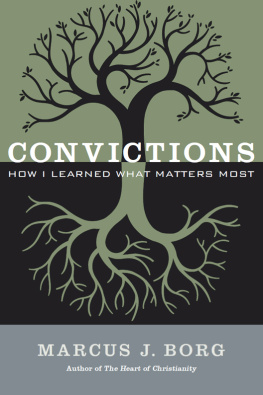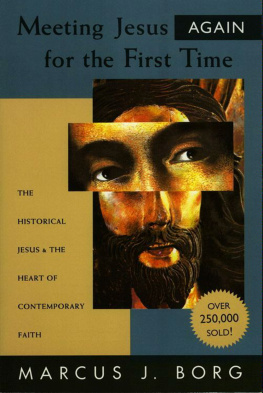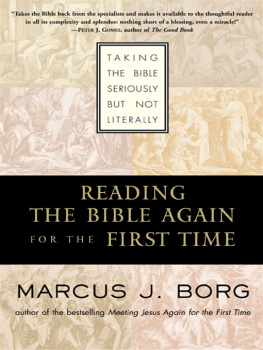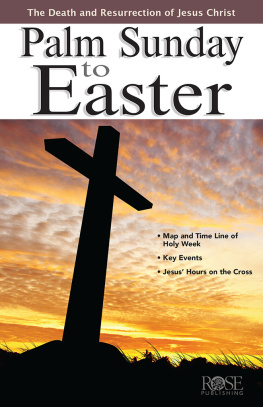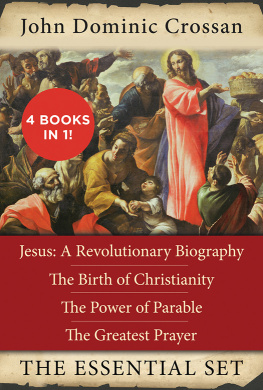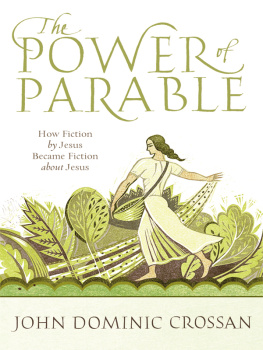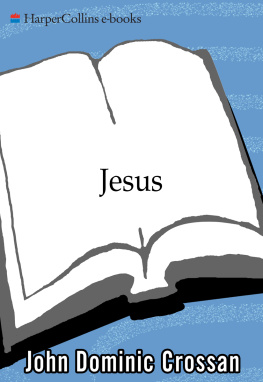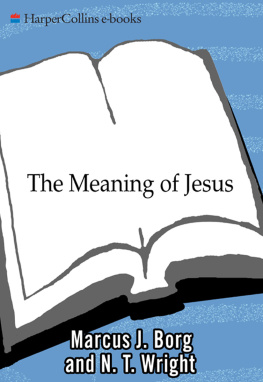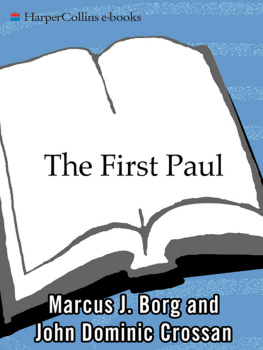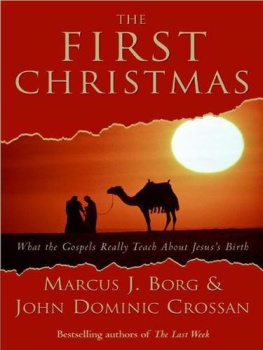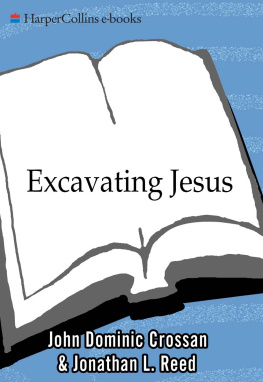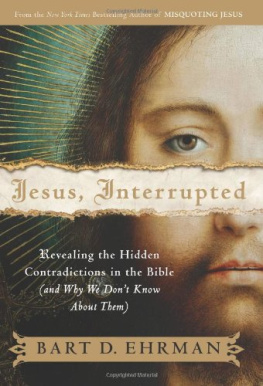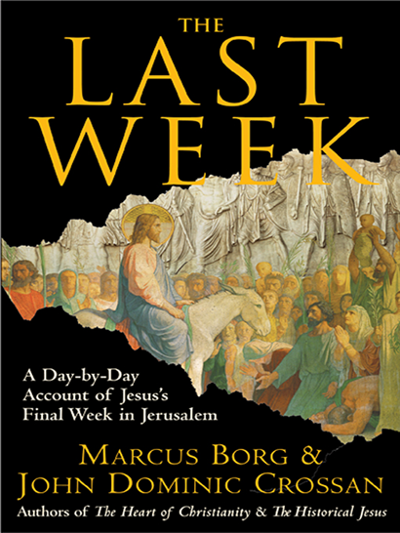MARCUS J. BORG
T his book is about the last week of Jesuss life. It is a week of extraordinary importance for Christians. With its climax on Good Friday and Easter, it is Holy Week, the most sacred time of the Christian year. And because of its centrality for the lives of Christians, how this story is told matters greatly. What was the last week of Jesuss life about? And because this story is seen as revelatory, as speaking to us today, what is it about?
Two years ago, on Ash Wednesday at the beginning of Lent, Mel Gibsons movie The Passion of the Christ made the death of Jesus big news in the United States and elsewhere. Cover stories in national news magazines, prime-time television shows, and major stories in newspapers across the country featured the movie. Remarkable: almost two thousand years after it happened, the death of Jesus was once again front-page news. As the novelist Flannery OConnor put it thirty years ago, we live in a Christ-haunted culture.
The movie was controversial and disclosed a division among contemporary Christians. Millions of Christians welcomed it enthusiastically and proclaimed it to have great potential for Christian evangelism in our time. Many were deeply moved by its graphic portrayal of how much suffering Jesus experienced for us. Other Christians were disturbed by itby its portrayal of the Jews and by its message that all of us were or are responsible for the death of Jesus: Jesus had to experience all of this horror because of us.
The movie had an additional effect. It reinforced a widespread but much too narrow understanding of the passion of Jesus. Mel Gibson called his film The Passion of the Christ and based his screenplay on Anne Catherine Emmerichs The Dolorous Passion of Our Lord Jesus Christ. Both authors understood the term passion in the context of its traditional Roman Catholic and broader Christian background. Passion is from the Latin noun passio, meaning suffering.
But in everyday English we also use passion for any consuming interest, dedicated enthusiasm, or concentrated commitment. In this sense, a persons passion is what she or he is passionate about. In this book we are deliberately playing those two meanings against one another. The first passion of Jesus was the kingdom of God, namely, to incarnate the justice of God by demanding for all a fair share of a world belonging to and ruled by the covenantal God of Israel. It was that first passion for Gods distributive justice that led inevitably to the second passion by Pilates punitive justice. Before Jesus, after Jesus, and, for Christians, archetypically in Jesus, those who live for nonviolent justice die all too often from violent injustice. And so in this book we focus on what Jesus was passionate about as a way of understanding why his life ended in the passion of Good Friday. To narrow the passion of Jesus to his last twelve hoursarrest, trial, torture, and crucifixionis to ignore the connection between his life and his death.
We do not in this book intend to attempt a historical reconstruction of Jesuss last week on earth. Our purpose is not to distinguish what actually happened from the way it is recorded in the four gospels, which proclaim it as good news (gospel). We intend a much simpler task: to tell and explain, against the background of Jewish high-priestly collaboration with Roman imperial control, the last week of Jesuss life on earth as given in the Gospel According to Mark. Both of us have spent our professional lives focused on the historical Jesus, but we work together here on this humbler task: to retell a story everyone thinks they know too well and most do not seem to know at all.
We have chosen Mark for two reasons. The first is that Mark is the earliest gospel, the first narrative account of Jesuss final week. Written some forty years after the life of Jesus, Mark tells us how the story of Jesus was told around the year 70. As such, it is not straightforward history, but, like all the gospels, a combination of history remembered and history interpreted. It is the story of Jesus updated for the time in which Marks community lived.
Scholarship of the past two hundred years has reached a fairly massive consensus not only that Mark was the first of the four New Testament gospels, but also that Matthew and Luke used it as their major source and that, quite probably, John used those earlier versions as his major source. In discussing Mark, therefore, we will also often refer to ways in which those later authors changed his version. This will be especially important where such changes have become better known than Marks original version.
But there is also a second and equally important reason for choosing Mark. Namely, Mark alone went out of his way to chronicle Jesuss last week on a day-by-day basis, while the others kept some but not all of those indications of time. Here is what Mark says (with the addition of our day names):
Sunday: | When they were approaching Jerusalem (11:1) |
Monday: | On the following day (11:12) |
Tuesday: | In the morning (11:20) |
Wednesday: | It was two days before the Passover (14:1) |
Thursday: | On the first day of Unleavened Bread (14:12) |
Friday: | As soon as it was morning (15:1) |
Saturday: | The Sabbath (15:42; 16:1) |
Sunday: | Very early on the first day of the week (16:2) |
Moreover, Mark alone also details morning and evening events for three of those days: Sunday (11:1, 11), Monday (11:12, 19), and Thursday (14:12, 17).
Finally, Mark alone chronicles Fridays events in careful three-hour intervals (like Roman military watch times):
6 AM | As soon as it was morning (15:1) |
9 AM | It was nine oclock in the morning (15:25) |
12 noon | When it was noon (15:33) |
3 PM | At three oclock (15:34) |
6 PM | When evening had come (15:42) |
In other words, Mark alone has taken considerable care to tell his story so that hearers or readers can follow events day by day and eventually hour by hour. It seems almost a deliberate basis for a Holy Week liturgy that goes from Palm Sunday to Easter Sunday without skipping anything in between.
That last sentence introduces another major reason for this book. Christian liturgy has started to collapse Holy Week into its last three days and renamed Palm Sunday as Passion Sunday. On the one hand, Passion Sunday and Easter Sunday form a powerful dyad of death and resurrection. On the other, the loss of Palm Sundays enthusiastic crowds and of all those days and events in between may weaken or even negate the meaning of that death and therefore of that resurrection. Our hope is that this slender volume may supply a needed corrective and proper narrative basis both for sacred liturgy within the church and for story, play, and film inside or outside it. Most especially, after two thousand years of theological anti-Judaism and even racial anti-Semitism derived from this story, it is time to read it again and get it right, to follow it closely and understand fully its narrative logic.

